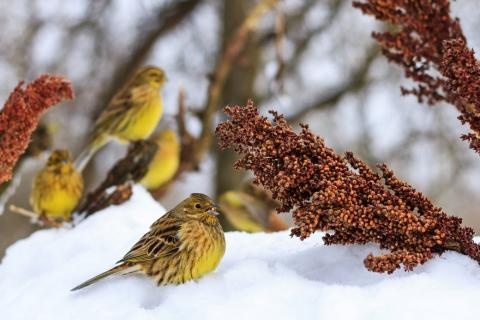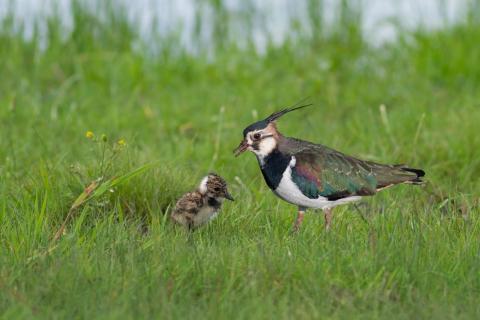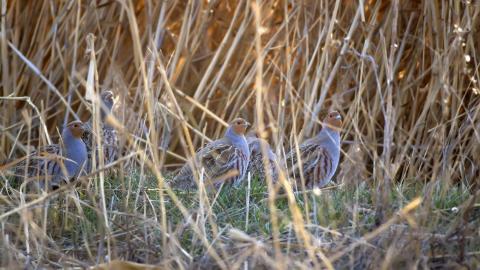14 January 2022
Dr Emma Davies: IBERS, Aberystwyth University.
- Small farmland management changes can produce significant benefits for bird populations.
- Supplementary winter feeding reduces winter bird mortality, however, whole ecosystem changes are needed to reverse bird population declines.
- Methods to improve farm bird habitat should be considered at a farm and landscape level so that ecosystems are appropriately and effectively supported.
- Managing farmland to support birds can also have a range of positive impacts on farm productivity, sustainability, and animal welfare.
Introduction
Agricultural policies and subsidies developed between the 1970’s and 1990’s encouraged an increase in food productivity and food security. These policies were very successful; however, an unintended consequence was that land use change and intensive farming methods contributed to natural habitat and biodiversity loss. As a result, recent government policy has shifted to support the agricultural sector not only for the production of food, but also for public goods, encompassing food production, biodiversity, and climate change mitigation. One of the most notable impacts on biodiversity, is the decline in the population levels and distributions of farmland bird species. However, managing farmland in ways that support bird populations can have a range of positive impacts, not only for bird populations, but also for farm productivity, sustainability, and animal welfare. With the end of the basic payment scheme at the end of 2023 quickly approaching, thinking about making changes that will support farmland birds and the wider farm ecosystem is also likely to help farms prepare for the introduction of the new Sustainable Farming Scheme, due to be introduced from 2025.
Some farms in Wales are already trialling ways to support farmland bird species, supported by a European innovation partnership project called the Welsh farmland bird initiative.
Challenges facing farmland bird populations
It is estimated that since 1970, farmland bird populations have declined by approximately 50%. Seed and grain eating species such as the yellowhammer, bullfinch, corn bunting, skylark, and yellow wagtail, waders such as the lapwing, curlew, and redshank, and game birds such as the grey partridge and black grouse have experienced significant population decline and contraction. Populations of birds of prey such as the kestrel, merlin and barn owl have also declined.
Farmland birds such as the corn bunting have experienced significant population declines.
Farmland bird population declines are associated with reductions in winter survival, reductions in breeding season survival, and a reduction of successful nests producing fledged offspring. These factors are linked to the shortage of winter and summer food, a loss of vital breeding habitat, and an increase of predation, within both arable and grassland systems.
Food for seed eating birds comes from sown seed, seed spilt during harvest, and seed from broad leafed weed plants present within crop and grassland swards. Seed bearing plants are also abundant in hedgerows, meadows, and field margins. Insectivorous birds rely on the insect populations within all of these environments, as well as wetland habitats.
However, a loss of winter food supply is considered to be one of the main factors that drives bird population decline. Over recent decades, winter food supplies have decreased due to a shift from spring sown to winter sown crops, a loss of arable cropping within predominantly grassland systems, and the intensification of both arable and grassland management.
Moving from spring-sown to autumn-sown cereals significantly reduces the availability of food throughout the year, as spring sown grain and grain spilled during harvest are not available. Stubbles from spring sown crops that provide vital winter feeding grounds are not available in winter sown systems. The short-vegetation nesting and feeding sites favoured by ground nesting species such as the lapwing and skylark are also not available as winter-sown cereals are too tall and dense by the start of the nesting season. Even in spring sown systems, food scarcity is intensified during late winter as stubbles and seed crops are cultivated in February in preparation for spring sowing.
Widespread herbicide use and intensive weeding practices significantly reduce the availability of seed-bearing plants, and widespread insecticide use reduces insect abundance. Together with the utilisation of monoculture arable systems and competitive single species grassland, the biodiversity of flowering, seed and grain bearing plants, are severely restricted. Practices such as the increased frequency of mowing grass for silage production also significantly decreases the biodiversity of farmland ecosystems.
The improvement of previously unproductive marginal land and the removal of hedgerows further reduces the availability of food and habitat resources. The extensive drainage of wet grassland habitats for dry grassland and arable cereal production has also contributed to the decline of wetland wading species, as these birds rely on the invertebrate populations present in such habitats.
As a result, across the UK and Europe, bird populations have declined most significantly in intensively managed, highly productive lowland areas. However, bird populations in upland areas which are typically devoid of arable crops have also experienced significant declines. For example, the upland areas of Wales have experienced declines of ground nesting birds and birds associated with heather moorland such as the red grouse and merlin. These declines are associated with a sustained increase in stock numbers and intense grazing pressures.
How can farmland bird species be supported?
Food stress is highest in late winter due to food scarcity and increasing metabolic demand due to adverse weather conditions. Therefore, providing a supplementary food supply will increase winter survival rates. This has been demonstrated with station feeding, where large volumes of seed are provided at discrete locations. This method has been shown to slow the decline of species such as yellowhammer, reed bunting, and dunnock. However, station feeding methods have not halted or reversed the decline of bird populations, as high quality breeding habitats and summer food provision are also necessary for birds to raise offspring successfully. Therefore, introducing changes which increase whole ecosystem resources, including insect populations, the availability of seed, and breeding habitat are essential. Such adaptations can be introduced in both arable and grassland environments. This is important in regions such as Wales, where 81% of the 2.1 million hectares of land used for farming is composed of grassland.
One of the most effective ways to increase bird resources is to reduce or eliminate the use of herbicides and insecticides. Organically managed crop swards can support three times as many broad leaved weed species and significant increases in insect populations when compared to conventionally managed non-organic arable fields. This increase in plant and insect species diversity provides vital nest sites and food for developing chicks during the breeding season.
Alternatively, fields can be sown with seed mixtures specifically developed to provide food throughout the winter and breeding season. However, to be effective, sown crops need to be managed to ensure they are not depleted before spring. Mixtures based on brassicas such as mustard or kale provide cover, while the addition of triticale, oats, sorghum, quinoa, millet, buckwheat, sunflower, linseed and legumes are valuable seed producing species. Similarly, arable farms can increase the number of bird species they support by growing a variety of different crops, including cereal grains, pulses, and oil seeds.
Sowing mixtures of seed crops can help birds like yellowhammers survive winter.
Population studies have shown that while sky lark numbers are high in winter cereals during winter, winter cereals have low numbers of skylarks during the latter half of the breeding season (May-July), as birds require crops less than 30cm in height, and show a clear preference for spring sown crops and set aside land. Therefore, growing a mixture of winter sown and spring sown cereals will provide nesting sites and food throughout the year.
Combining organic practices with the development of set aside land areas can also be highly effective at increasing farm bird populations. Set aside land can be a permanent area of land which is allowed to organically develop a vegetative cover, or an area of land including a cereal crop, managed as part of a rotational set aside strategy. Both forms can provide food and quality habitat during winter and spring for several species, such as the grey partridge and skylark. Fixed set aside land can improve hedgerows and field margins, buffer watercourses and increase plant and insect biodiversity on exclusively arable farms. However, for set aside land to be effective, it needs to be managed appropriately for wildlife. For example, set aside land needs to be mown once every one-two years to prevent secondary grass succession which will reduce plant biodiversity. However, cutting is most effective at the very end of the breeding season (late August) to protect late nesting birds. Similarly, when in a rotational system, removing vegetation cover in preparation for cultivation is optimally achieved by spraying as late as possible, as this protects nests from direct disturbance and allows vegetation cover and insect numbers to decline gradually over a number of weeks.
Suitable areas can be managed to create wet farmland habitats, that are important for wetland species such as the lapwing. Bare ground improves access to food for probing birds, wetland vegetation provides nesting sites, and permanent water sources support wetland-dependant invertebrates that are food for both insectivorous and seed eating birds. Methods to create wet farmland habitats include clearing ditches, creating new waterways by excavating shallow channels in the soil, or by constructing small wetland habitats. Long term adaptations involve adopting conservation or minimum tillage practices to increase insect biodiversity and reduce the disruption of the soil structure.
Lapwings prefer mixed farming systems with extensively managed wet grasslands.
Restoring the quality of natural features such as hedgerows and field margins (arable headlands or rough grassland margins) supports bird populations as these are used by a range of species for food, shelter, and nesting sites. The factors most associated with hedgerow quality are its size, the abundance of trees, and the structural diversity and complexity of its native vegetation. However, to maximise the benefits of hedgerows, they should be carefully managed and integrated into the landscape. The effectiveness of hedgerows can be increased by combining them with other habitats such as woodlands, wildflower strips, banks and ditches, and siting them away from hazards such as roads. However when siting hedgerows, care must be taken not to disturb other important habitats such as meadow grasslands, as some bird species have minimum habitat size requirements. Therefore, while practices such as hedgerow replacement are widely supported by agri-environment schemes, they should be carefully considered at the individual farm level.
Grey partridge use thick vegetative cover provided by field margins for nesting.
Grassland management practices including reducing stocking densities and grazing pressures are important for healthy moorland, heathland, and wet grassland, in order to conserve nesting sites and food provisions. Importantly, grassland farms, devoid of any arable agriculture can provide vital seed supplies to birds throughout winter when there are few other seed bearing plants available by allowing swards of ryegrass (Lolium spp) to produce seed.
Benefits of supporting farmland bird populations
Farmland bird populations have significant ecological value and are recognised as one of the most important indicators of ecosystem quality and farming practice sustainability. Investing in agricultural landscapes to support farmland bird populations can provide farms with many other benefits and services, in addition to bird conservation.
For example, high quality hedgerows and field margins provide wildlife corridors, connecting ecosystems for a range of animal species, thus supporting the biodiversity of mammals, birds and insects. These features also provide habitat for pollinating insects essential for productivity, and predatory insects, important for biologically controlling pests. Hedges reduce wind speed, thereby reducing soil erosion, providing shelter to crops, and acting as barriers to windborne pests. Hedges and mature trees also provide welfare benefits to livestock by providing shelter during times of extreme weather conditions, during both summer and winter.
Hedgerows, field margins and areas of set aside land also improve soil quality and form parts of vegetative and riparian buffers which remove pollutants from both underground and surface run off, reducing watercourse pollution, and improving water quality. This is especially beneficial in areas designated nitrate vulnerable zones (NVZs), which since, April 2021, includes the whole of Wales.
Managing crops and grassland less intensively also improves soil health, contributing to sustained or even increased productivity, while simultaneously reducing tillage, pesticide and fertiliser inputs and costs. Importantly, managing landscapes to support soil health and biodiversity is also likely to increase the carbon sequestration capabilities of farmland, contributing to the mitigation of climate change.
Are on-farm changes effective?
Across the UK, targeted interventions focused on individual species’ ecology have successfully halted and reversed the decline of high priority species such as the cirl bunting, corncrake and stone curlew. However, the general trend for farm-land bird decline has not yet been reversed.
This is because the uptake of general agri-environment schemes is highly variable and general interventions seem to have mixed species-specific results. For example, one study focused on lowland areas of England found that the provision of winter stubble and sown wild bird seed areas, grassland management and hedgerow management were associated with both increases and decreases to bird population growth rates, depending on the species studied. These mixed results reflect the degree to which the different management options address the factors limiting specific species populations and highlights the need for considered farm and landscape approaches.
Adopting a number of measures is most likely to lead to increased population growth rates. For example, a six year study on a large-scale intensive lowland farm, found that through a combination of set aside land, a mixed cropping regime and a low herbicide and insecticide strategy, a rapid and sustained increase in bird populations was produced, with increases as high as 46% and 300% for skylarks and grey partridge respectively.
A study examining the effectiveness of Tir Gofal (the prominent agri-environment scheme in Wales between 1999-2013) found that the scheme had positive impacts on the populations of many farmland bird species throughout Wales. For example, hedgerow management had significant positive effects on dunnock, greenfinch, house sparrow, linnet and yellowhammer. The study also found that managing grassland less intensively with reduced pesticide use had positive effects on linnet populations, while minimising or reducing stocking density in woodland areas produced population increases for a range of species, including blackbirds, bullfinch, spotted flycatcher, marsh tit and blackcap. Additionally, arable farms that provided winter seed positively impacted greenfinch populations, while farms that supported invertebrates by limiting their use of herbicide and insecticide also positively influenced whitethroat numbers.
Summary
Increasing winter bird food provision decreases bird mortality. However, food provisions need to be maintained throughout late winter to be effective. To reverse the trend for decreasing bird populations, additional farm adaptations that provide quality nesting sites and breeding season food resources are needed. The choice of adaptation should address the ecological needs of the species in the landscape, and as a result, may have to exceed the expectations set by agri-environment schemes. Although the area of farmland utilising such methods needs to be significant, improving the quality of habitats is equally as important to effectively influence bird populations.
If you would like a PDF version of the article, please contact heledd.george@menterabusnes.co.uk




